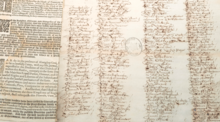The Protestation of 1641 was an attempt to avert the English Civil War. Parliament passed a bill on 3 May 1641 requiring those over the age of 18 to sign the Protestation, an oath of allegiance to King Charles I and the Church of England, as a way to reduce the tensions across the realm. Signing them was a necessity in order to hold public office. Those that were not willing to sign it were also listed under it as refusing to pledge its oath.

The Protestation was also a part of a context of political, religious, and social anxiety due to intense changes in a short period in England during the Early Modern era. As further changes and armed conflict loomed closer, both Parliament and those loyal to the king attempted to find ways to avoid it. One of the ways they found to do that was via oath of allegiances, the first of which was the Protestation. It began in May 1641 with the intention of getting all Englishmen above the age of 18 to swear a vow to defend King Charles I and the Church of England. Ultimately it failed and tensions continued to escalate between Parliament and King Charles I, eventually leading to the start of the English Civil Wars in August 1642. However, the Protestation is an enlightening historical phenomenon that help us understand the process that led to the English Civil Wars and attempts that people made to avert a costly conflict, even from those at the center of the hostilities.
In the context of the English Civil Wars, the Protestation is an interesting, but often unexplored topic. Apart from its implications in population census and local historiography, it provides an understanding of how people during the decade of 1640 attempted to avoid a potentially costly and bloody conflict. It happened not once, but three times until the civil wars broke out. The Protestation also fits in the timeline of the English Civil Wars, which shook the realm and altered its relationships. Their outcome was the beheading of King Charles, the temporary suspension of kingship under Oliver Cromwell's rule, and the English Restoration under Charles II, showing the complexity of events and general social anxiety reigning during Stuart England.